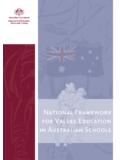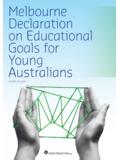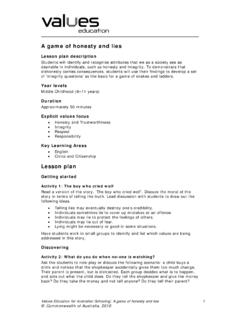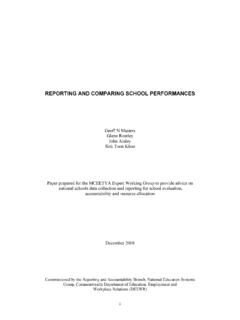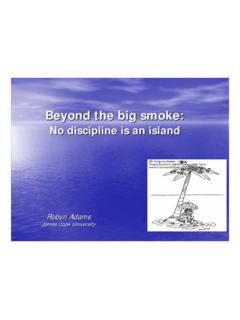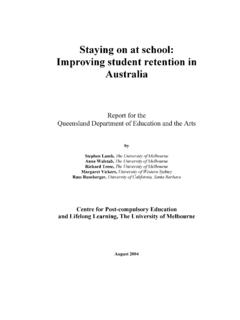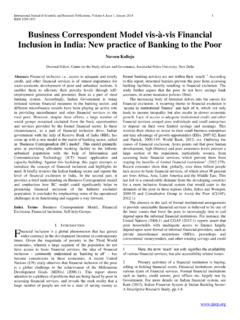Transcription of The value of inclusion - curriculum.edu.au
1 The value of inclusion Lesson plan description Australia is populated by a diverse range of people with varied backgrounds and understandings. In order for people to get along in a multicultural society, they may share values including a belief in equality, freedom and respect for one another. Understanding, tolerance and inclusion are also important. Students will explore some of these values through examining and thinking about examples of inclusion , exclusion and segregation in their own lives and in the broader community. Students will play a game and view a film clip on racial segregation in Australia in the 1950s. Students will research the Australian Freedom Rides and reflect on changing attitudes. Students will consider values they admire in another Australian and how they could enact these in their own life.
2 Year levels Middle Childhood (8 11 years). Duration Approximately 50 minutes Note: research will incur additional time. Explicit values focus Care and Compassion Doing Your Best Fair Go Freedom Respect Responsibility Understanding, Tolerance and inclusion Key Learning Areas Studies of Society and Environment English Technology Lesson plan Getting started Activity 1: Class game NOTE: the following game needs to be handled sensitively as children who have experienced exclusion in their lives may find it frustrating. Play a familiar class game, modified with new' rules so that one group of students has additional restrictions imposed upon them. For example, play tips', but those in' must tip the other person on both shoulders and both elbows before they can be in.
3 After a couple of minutes of playing, seat the students and ask for their comments on the new game. Continue with questions, to identify the language of a fair go' and inclusion , such as: Values Education for Australian Schooling: The value of inclusion 1. Commonwealth of Australia, 2010. What was the best part of this new game? (Make sure a range of students comment on their opinion.). How many people were tipped and caught by those who were in'? Did everyone get to join in on the game? Why / why not? Why isn't this game suitable for students to play? What values are not being enacted in the new game? How could this game be modified to ensure everyone enjoys playing? What values would be put into action following these modifications?
4 Activity 2: Film clip Observe the film clip: Australian Screen Online, Swimmin'.. that's for white fella's' from the short film From Sand to Celluloid Two Bob Mermaid (1996), Ask the students to discuss the feelings of the main characters and the Aboriginal children. Discuss whether this occurs today in our swimming pools. Does it happen to any other cultures? Divide the class into four groups. Each group is given one of the following values words: Respect, Understanding, Tolerance or inclusion . Using the values word as a prompt, groups explore and record on large sheets of paper how people act, speak and feel when swimming at their local swimming pool, school swimming carnival or at the beach when these values are being enacted.
5 For example, Respect might entail paying entrance fees in an orderly way, lining up at the canteen, sharing the grass area fairly, reminding someone that they have left their towel behind, saying thank you', nodding one's head, smiling. If this situation is inappropriate for your group of students, then the situation could be altered to reflect another sporting event they have attended or seen on television. Students report back on their topic and observe the similarities between the values positive comments, feeling happy and content, caring for each other, feeling included and including others, and feeling safe. Divide students into pairs, and have each pair think about the film and list what events or values might have brought about the changes since the late 1950s.
6 Have each pair join up with another and compare their thoughts, adding other ideas to their list. Repeat so that each group of four joins with another, comparing their thoughts and adding to their list. Have a representative from each final group read their thoughts aloud, and write these on large sheets of paper. Tell students that they will review this list later in order to see whether or not their assumptions were correct. Discovering Activity 3: Segregation Introduce and expand upon the meaning of the word segregation', identifying synonyms such as discrimination, separation, segregation, remoteness, loneliness, seclusion, division, or disconnection, and antonyms, for example inclusion , integration, unification, or union. Record these on the whiteboard.
7 Ask students to identify times when segregation is shown in the film clip. Review the clip a few times if needed. Have students jointly record situations where they may have experienced or have noted segregation. For example, they may have been prevented from lighting a fire while camping, or may have experience of scripture classes, refugee camps, mosques, school discos, sex-segregated toilets, or restrictions related to swimming pools. Discuss reasons why the segregation may Values Education for Australian Schooling: The value of inclusion 2. Commonwealth of Australia, 2010. have occurred. This may include safety, religious, racial, economic, or social reasons. Ask students to then discuss situations where they have experienced or have noted inclusion .
8 For example, they may have noticed the integration of special needs students into class, or have been asked to join in a game, experienced a buddy system with different-aged students, multicultural events, ecumenical or interfaith events. Activity 4: Jigsaw reading In groups of four to six, students are given a topic to read about, listen to documented radio dialogue and record notes from the website of the Australian Freedom Rides, , to share with others in the class. Group topics could include US Freedom Rides, Charles Perkins, the Moree Freedom Ride, the Walgett Freedom Ride, Black and Proud of It', and the aftermath. Students present their work to the class. Records dot points of the events, facts and other interesting information.
9 Together with the students, place the topics in sequential order. Bringing it together Activity 5: Australian with values Review the following in order to recap the language and attitude of the values we hold today for all Australians: Film clip: refresh students' memory of the content concerning racial segregation and discrimination Meshing list: review the original thoughts of students compared to their thoughts after researching the Freedom Rides. On an A3 piece of paper, students create a design of an Australian with values'. This may be someone they know such as a parent, brother, sister, grandparent, or neighbour. Students need to give examples of the values this person holds and lives in their daily life. They should also select one of the values that they admire and explain how they would enact it in their own life.
10 Notes for teachers Additional reading: Biographies of well-known Aboriginal and Torres Strait Islander people may be useful. For example: Neville Bonner, the first Indigenous Australian to become a member of the Parliament of Australia; Professor Mick Dodson, academic and Indigenous rights advocate; Professor Larissa Behrendt, academic, writer and Aboriginal affairs advocate; David Unaipon, preacher, inventor and writer; Lowitja O'Donoghue, nurse and Founding Chair of the Aboriginal and Torres Strait Islander Commission; Mandawuy Yunupingu, musician and principal; Evonne Goolagong Cawley, tennis player; Cathy Freeman, athlete; Benjamin Christie, celebrity chef; Ernie Dingo, actor and television presenter; Emily Kame Kngwarreye, artist; Clifford Possum Tjapaltjarri, artist.
